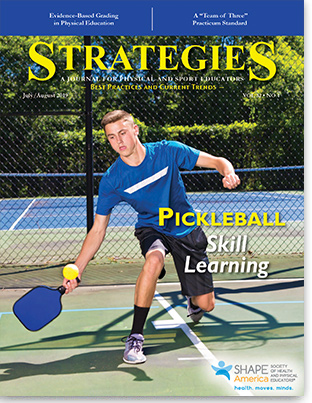 Strategies Table of Contents
Strategies Table of Contents
You Dinked My Battleship: The Dinking Game for Pickleball Skill Learning
James Zagrodnik

Pickleball’s origin dates back to 1965 (www.usapa.org) and was initially presented in the Journal of Physical Education and Recreation in 1976 by Rex Davis in a short one-page introduction to the game’s history, rules, scoring and penalty zone. Since then, the rules of pickleball have changed very little but advancements in paddle technology and ball construction have recently transformed as rapidly as pickleball’s popularity. According to the United States Pickleball Association (USAPA 2018; www.usapa.org), pickleball is currently one of America’s fastest-growing sports and is estimated to have 2.8 million players as of 2017 and a growth rate of 1.8% from 2014 to 2015.
One contributing factor to this recent growth could be how easy it is to learn (Leach & Colgate, 1982). With a large racquet face area and short handle, a beginner’s success rate at hitting the ball is very high. Th e ball is larger, lighter, and typically moves at a slower rate than balls in all the other racquet sports, which also allows for greater reaction time and aides in decision making and capacity to have ball contact. The underhanded swinging motion of the arm and paddle for most shots may also assist beginners in striking the ball more consistently than many other racquet-sport swing types. In addition, the court is relatively small — the size of a badminton court. Thus, when playing doubles, as the game is most often played, limited mobility and court coverage is required, resulting in more time to effectively make a good stroke on the ball. Adding to skill learning can be that the net is lower than a tennis net, which possibly allows for high rates of success for beginners to get the ball over the net and in play.
It should also be mentioned that the social nature of pickleball to have fun and be active lends itself to welcoming all people no matter their skill level. The relative ease to learn the
basic skills to play pickleball allows people to feel accomplished and successful very early on in their learning progression, thus encouraging continued participation and willingness to play the game.
To read the rest of this article, click here to download a pdf.